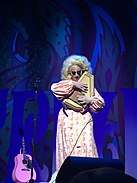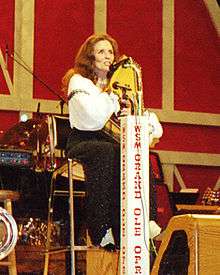Autoharp
The autoharp is a musical instrument in the chorded zither family. It features a series of chord bars attached to dampers, which, when pressed, mute all of the strings other than those that form the desired chord. Although the word autoharp was once a trademark of the Oscar Schmidt company, the term has colloquially come to be used for any hand-held, chorded zither, regardless of manufacturer.[2][3]
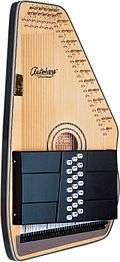 Modern autoharp | |
| Classification | 31 |
|---|---|
| Inventor(s) | Charles F. Zimmermann US 257808[1] |
| Playing range | |
| String instrument | |
| Related instruments | |
| Zither, marxophone, dolceola | |
| Builders | |
| Oscar Schmidt | |
History

Debate exists over the origin of the autoharp. Charles F. Zimmermann, a German immigrant in Philadelphia, was awarded US 257808 in 1882 for the design of a musical instrument that included mechanisms for muting certain strings during play. He named his invention the "autoharp".[1] Unlike later autoharps, the shape of the instrument was symmetrical, and the felt-bearing bars moved horizontally against the strings instead of vertically. It is not known if Zimmermann ever commercially produced any instruments of this early design. Karl August Gütter of Markneukirchen, Germany, built a model that he called a Volkszither, which most resembles the autoharp played today. Gütter obtained a British patent for his instrument circa 1883–1884. Zimmermann, after returning from a visit to Germany, began production of the Gütter design in 1885, but with his own design patent number and name. Gütter's instrument design became very popular, and Zimmermann has often been misnamed as the inventor.
Trademark
A stylized form of the term autoharp was registered as a trademark in 1926.[4] The word is currently claimed as a trademark by the U.S. Music Corporation, whose Oscar Schmidt division manufactures autoharps.[5] The USPTO registration, however, covers only a "Mark Drawing Code (5) Words, Letters, and/or Numbers in Stylized Form" and has expired.[6] In litigation with George Orthey, it was held that Oscar Schmidt could only claim ownership of the stylized lettering of the word autoharp, the term itself having moved into general usage.
Construction

The autoharp body is made of wood, and has a generally rectangular shape, with one corner cut off. The soundboard generally features a guitar-like sound-hole, and the top may be either solid wood or of laminated construction. A pin-block of multiple laminated layers of wood occupies the top and slanted edges, and serves as a bed for the tuning pins, which resemble those used in pianos and concert zithers.
On the edge opposite the top pin-block is either a series of metal pins, or a grooved metal plate, which accepts the lower ends of the strings. Directly above the strings, on the lower half of the top, are the chord bars, which are made of plastic, wood, or metal, and support felt or foam pads on the side facing the strings. These bars are mounted on springs, and pressed down with one hand, via buttons mounted to their topside. The buttons are labeled with the name of the chord produced when that bar is pressed against the strings, and the strings strummed. The back of the instrument usually has three wooden, plastic, or rubber "feet", which support the instrument when it is placed backside down on a table top, for playing in the traditional position.
Strings run parallel to the top, between the mounting plate and the tuning pins, and pass under the chord bar assembly. Modern autoharps most often have 36 strings, with some examples having as many as 47 strings, and rare 48-string models (such as Orthey Autoharps No. 136, tuned to G and D major). They are strung in a semi-chromatic manner which, however, is sometimes modified into either diatonic or fully chromatic scales. Standard models have 12, 15 or 21 chord bars available, providing a selection of major, minor, and dominant seventh chords. These are arranged for historical or systemic reasons.[7] Various special models have also been produced, such as diatonic one-, two-, or three-key models, models with fewer or additional chords, and a reverse-strung model (the 43-string, 28-chord Chromaharp Caroler).
Range and tuning
The range is determined by the number of strings and their tuning. A typical 36-string chromatic autoharp in standard tuning has a 3½ octave range, from F2 to C6. The instrument is not fully chromatic throughout this range, however, as this would require 44 strings. The exact 36-string tuning is:
| Octave | Tuning | |||||||||||
|---|---|---|---|---|---|---|---|---|---|---|---|---|
| Bass octave | F2 | G2 | C3 | D3 | E3 | |||||||
| Tenor octave | F3 | F♯3 | G3 | A3 | A♯3 | B3 | C4 | C♯4 | D4 | D♯4 | E4 | |
| Alto octave | F4 | F♯4 | G4 | G♯4 | A4 | A♯4 | B4 | C5 | C♯5 | D5 | D♯5 | E5 |
| Soprano octave | F5 | F♯5 | G5 | G♯5 | A5 | A♯5 | B5 | C6 | ||||
There are a number of gaps in the lowest octave, which functions primarily to provide bass notes in diatonic contexts; there is also a missing G♯3 in the tenor octave. The fully chromatic part of the instrument's range begins with A3 (the A below middle C).
Diatonically-strung single-key instruments from modern luthiers are known for their lush sound. This is achieved by doubling the strings for individual notes. Since the strings for notes not in the diatonic scale need not appear in the string bed, the resulting extra space is used for the doubled strings, resulting in fewer damped strings. Two- and three-key diatonics compromise the number of doubled strings to gain the ability to play in two or three keys, and to permit tunes containing accidentals, which could not otherwise be rendered on a single key harp. A three-key harp in the circle of fifths, such as a GDA, is often called a festival or campfire harp, as the instrument can easily accompany fiddles around a campfire or at a festival.
Chord bars
The standard, factory chord bar layout for a 12-chord autoharp, in two rows, is:
| Gm | A7 | Dm | E7 | Am | D7 | ||||||||||||
| B♭ | C7 | F | G7 | C | G |
The standard, factory chord bar layout for a 15-chord instrument, in two rows, is:
| D | Gm | A7 | Dm | E7 | Am | D7 | ||||||||||||||
| E♭ | F7 | B♭ | C7 | F | G7 | C | G |
The standard, factory chord bar layout for a 21-chord instrument is in three rows:
| E♭ | B♭ | F | C | G | D | A | ||||||||||||||
| F7 | C7 | G7 | D7 | A7 | E7 | B7 | ||||||||||||||
| A♭ | B♭7 | Cm | Gm | Dm | Am | Em |
A variety of chord bar layouts may be had, both in as-delivered instruments, and after customization.[8]
Electric autoharp
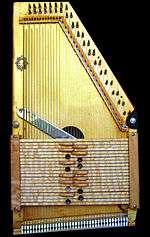
Until the 1960s, no pickups were available to amplify the autoharp other than rudimentary contact microphones, which frequently had a poor-quality, tinny sound. In the early 1960s, a bar magnetic pickup was designed for the instrument by Harry DeArmond, and manufactured by Rowe Industries. Pinkerton's Assorted Colours used the instrument on their 1966 single "Mirror, mirror".[9] In the 1970s, Oscar Schmidt came out with their own magnetic pickup. The Evil One, a 1979 hard rock album by Roky Erickson and the Aliens prominently featured the electric autoharp of Bill Miller which granted "an unearthly edge" to the music.[10]
Shown is a 1930 refinished Oscar Schmidt Inc. Model "A". This harp has two DeArmond magnetic pickups (one under the chord bars), with a d'Aigle fine-tuning mechanism, and d'Aigle chord bar assembly, and was used in a 1968 MGM Records/Heritage Records recording by Euphoria.
Variants
A synthesized version of the autoharp, the Omnichord, was introduced in 1981 and is now known as the Q-Chord, described as a "digital songcard guitar".
Playing technique
As initially conceived, the autoharp was played in the position of a concert zither, that is, with the instrument set flat on a table (there are three "feet" on the back for this purpose), and the flat-edge of the instrument (below the chord bars) placed to the player's right. The left hand worked the chord buttons, and the right hand would strum the strings in the narrow area below the chord bars.[11] Right hand strums were typically done with a plectrum similar to a guitar pick, made of shell, plastic, or compressed felt. A strum would usually activate multiple strings, playing the chord held down by the left hand.
Partly because of this playing mode, the autoharp came to be thought of as a rhythm instrument for playing chordal accompaniment, and even today many still think of the instrument in that way. New techniques have been developed, however, and modern players can play melodies on the instrument: diatonic players, for example, are able to play fiddle tunes using open-chording techniques, "pumping" the damper buttons while picking individual strings. Skilled chromatic players can perform a range of melodies, and even solos including melody, chords, and complex rhythmic accompaniments.
In the mid-20th century performers began experimenting with taking the instrument off the table and playing it in an upright position, held in the lap, with the back of the instrument (having the "feet") held against the chest. Cecil Null, of the Grand Ole Opry is usually credited as the first to adopt this playing style in public performance, in the 1950s. In this position the left hand still works the chord buttons, but from the opposite edge of the instrument, and the right hand still executes the strums, but now plays in the area above the chord bars. (See Joe Butler illustration, below.) This playing mode makes a wider area of the strings available to the picking hand, increasing the range of tonal possibilities, and it proved very popular. It was soon adopted by other performers, notably by members of the Carter Family.
By the early 1970s some players were experimenting with finger-style techniques, where individual fingers of the right hand would pluck specific strings, rather than simply hold a pick and strum chords. Bryan Bowers became a master of this mode of playing, and developed a complex technique utilizing all five fingers of his right hand. This allows him to play independent bass notes, chords, melody, and counter melodies as a soloist. Bowers was also one of the early pioneers in adding a strap to the instrument and playing it while standing up.
Notable performers
Kilby Snow (May 28, 1905 – March 29, 1980) was an American folk musician and virtuoso autoharpist, who won the title of Autoharp Champion of North Carolina at the age of 5. He developed the "drag note" playing style, a technique that relied on his left-handedness to produce "slurred" notes. Although his recorded output is small (a single album for Folkways Records in the 1960s), he has been enormously influential among autoharpists, and is regarded by many as the first modern autoharp player.[12]
Mother Maybelle Carter of the original Carter Family brought the instrument to prominence in the late 1940s by using it as a lead instrument when performing with her daughters; The Carter Sisters. Other Family members such as Sara Carter, Janette Carter, Johnny Cash, and all of The Carter Sisters played the instrument as well. A vast number of recordings by all members of The Carter Family includes the use of an Autoharp.
Maybelle Carter's granddaughter Carlene Carter frequently plays the autoharp onstage and on her recordings; her song "Me and the Wildwood Rose", a tribute to her grandmother, makes prominent use of the autoharp.
Janis Joplin occasionally played the autoharp, which can be heard in her early, unreleased recording "So Sad to Be Alone".[13]
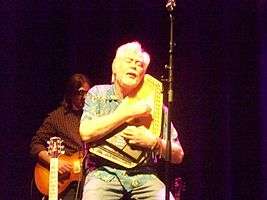
Several Lovin' Spoonful songs feature the autoharp playing of John Sebastian, including "Do You Believe in Magic" and "You Didn't Have to Be So Nice". He also played in the 1979 Randy VanWarmer hit song "Just When I Needed You Most".[14]
Bryan Bowers developed a complex finger-picking style of playing the autoharp (as opposed to the more common strumming technique) which he initially brought to bluegrass performances with The Dillards in the 1970s, and later to several of his own solo albums. Bowers was an early experimenter with customizing the instrument, often stripping it down to 8-10 chords to obtain more room above the chord bars for his right-hand fingers to work in; he also favors diatonic single-key autoharps, which have doubled strings, thus increasing the power and resonance of the tone. He is also a music educator, a strong advocate for the instrument, and was inducted into the Autoharp Hall of Fame in 1993.[15]
Comedian Billy Connolly has used an autoharp in his performances (mostly in earlier concerts during the 1980s).
British singer songwriter Corinne Bailey Rae regularly plays the autoharp and composed the title track from her 2010 album The Sea on the autoharp.[16]
Norwegian avant-garde artist Sturle Dagsland frequently performs with an autoharp.[17]
Singer/songwriter Brittain Ashford of the band Prairie Empire is known for using autoharp in her music, including the 2008 release "There, but for You, go I". She also regularly performs on the autoharp as part of her role in Ghost Quartet, a four-person song cycle composed by Dave Malloy.
In 2017, drag queen and singer-songwriter Trixie Mattel used the autoharp in her album Two Birds. Mattel also plays the autoharp as part of her regular drag performances.[18]
In 2020, KatieJane Garside of Ruby Throat released the album Geiger Counter, in which she is featured on autoharp.
See also
- Dolceola
- Guitar zither (chord zither, fretless zither)
- Guitaro
- Marxophone
- Omnichord (electronic autoharp)
- Zither
References
- The True History of the Autoharp
-
Kelly Williams (May 11, 2003). "Background of the Guitar-Zither". The Guitar-Zither Clearinghouse.
terminology on the "Chorded zither" (referred Autoharp without trademark infringement with Oscar Schmidt International), "Guitar-Zither" (patented by Fred Menzenhauer in 1894), and "Chord zither" (referred Guitar-Zither, appeared in The Oxford Companion to Musical Instruments, and The New Grove Dictionary of Musical Instruments). -
Gregg Miner and Kelly Williams (July 2011). "Selecting the Term". Fretless Zithers.
terminology and taxonomy of the "Fretless Zither" family instruments. - U.S. Patent and Trademark Office, Trademark Electronic Search System, September 7, 2006.
- Oscar Schmidt Autoharps
- U.S. Patent and Trademark Office, Trademark Electronic Search System, May 25, 2009.
- Orthey, Mary Lou (2001). Autoharp Owner's Manual, p.3. ISBN 0-7866-5883-5.
- "Autoharp How To Corner". daigleharp.com. 2016-04-23. Retrieved 2017-01-26.
- Ben Graham, The Battle for Texas's Psychedelic Music, from The 13th Floor Elevators to The Black Angels and Beyond (2015, John Hunt Publishing), Ch. 31
- Many instruments had (and still have) a paper or plastic card below the strings in this area, with a picture of a stylized piano-keyboard, as an aid to the player in locating specific notes with the picking hand.
- Kilby Snow
- "So Sad to Be Alone" audio recording
- Hyatt, Wesley (1999). The Billboard Book of No. 1 Adult Contemporary Hits (Billboard Publications), pages 228-9.
- Bryan Bowers
- Interview with Corrine Bailey Rae on BBC 6 Music about her Mercury nominated album "The Sea", Wednesday, 1 September 2010.
- "Indie electro, cybercore ja psühhedeelne vibe @ TMW" (in Estonian). www.postimees.ee. Retrieved 2016-09-01.
- "The Cover Art For Trixie Mattel's Country Album Is Perfection". LOGO News. Retrieved 2018-03-12.
